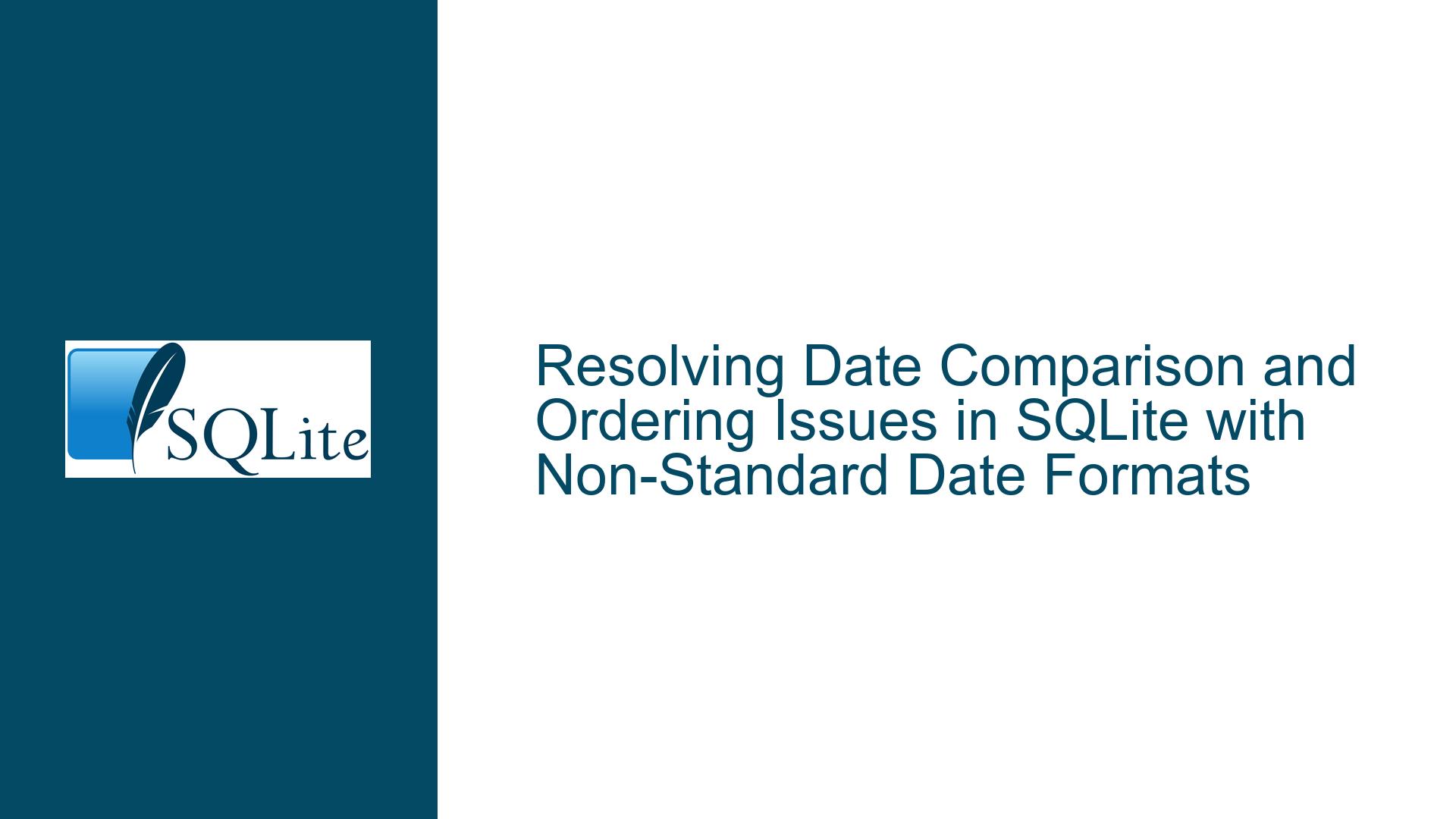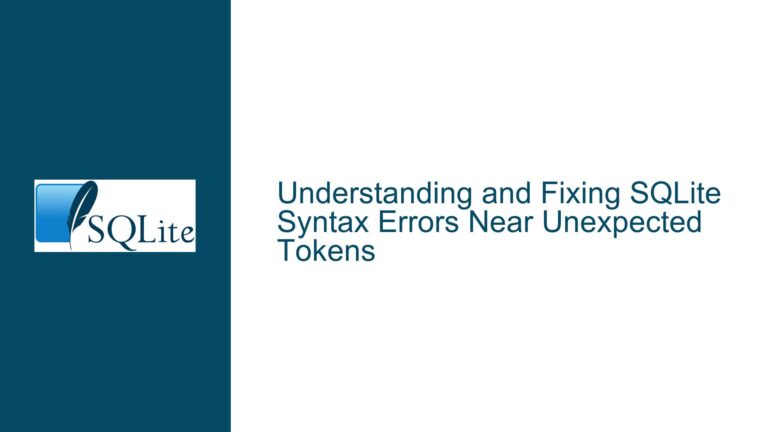Resolving Date Comparison and Ordering Issues in SQLite with Non-Standard Date Formats
Understanding and Fixing Date Comparison and Sorting Problems in SQLite
Issue Overview: Date/Time Comparisons Fail Due to String Format and Storage Choices
The core problem revolves around SQLite’s lack of a native DATE or DATETIME data type and the challenges this creates when storing and querying date/time values in non-standard formats. Users migrating from databases like Oracle or CA Ingres often assume SQLite has implicit date handling, leading to confusion when comparisons, range queries, or ordering operations produce incorrect results.
In this scenario, the user stored dates as strings in the DD/MM/YYYY HH:MM:SS format (e.g., 07/10/2020 11:54:31) and attempted to compare these values using strftime()-generated timestamps. Queries like WHERE UpdatedTimestamp >= strftime('%d/%m/%Y %H:%M:%S', datetime('now', '-1 day')) returned unexpected results, including data from months prior. The root cause lies in SQLite’s reliance on lexicographical (text-based) comparisons for string-typed date values. The DD/MM/YYYY format violates chronological order when sorted alphabetically because the day (DD) precedes the month (MM), creating mismatches between string order and actual date order. For example:
10/05/2024(May 10) will lexicographically appear after09/12/2023(December 9), even though the latter is earlier chronologically.
This issue is compounded by SQLite’s type system, where columns declared as DATETIME or DATE are treated as TEXT, INTEGER, or REAL based on affinity rules. Without strict schema enforcement (e.g., using STRICT tables), SQLite does not validate date formats, allowing invalid or misformatted strings to persist. Additionally, time zone handling (e.g., datetime('now') returning UTC by default) further complicates comparisons if not adjusted for local time.
Possible Causes: Misaligned Date Formats, Type Affinity Misconceptions, and Time Zone Oversights
1. Non-Chronological Date String Formats
- Problem: Storing dates in
DD/MM/YYYYor other non-ISO-8601 formats disrupts lexicographical ordering. SQLite compares these strings character-by-character, starting from the left. Since the day (DD) varies more frequently than the month (MM), comparisons between months or years fail to reflect true chronological order. - Example: A query for dates
>= '01/01/2024will include15/12/2023because the string15/12/2023starts with1, which is lexicographically greater than0in01/01/2024.
2. Misunderstanding SQLite’s Type Affinity System
- Myth: Declaring a column as
DATETIMEenforces date validation or special comparison logic. - Reality: SQLite uses type affinity, not rigid data types. A column declared as
DATETIMEhasNUMERICaffinity, which accepts integers, floats, or strings. Storing date strings in such columns does not trigger format validation. For example:CREATE TABLE events (id INTEGER, event_time DATETIME); INSERT INTO events VALUES (1, 'not a date'); -- Succeeds
3. Time Zone Mismanagement
- Issue: Using
datetime('now')without specifyinglocaltimereturns UTC time. If stored dates are in local time, comparisons will be off by the time zone offset. For example, comparing07/10/2020 18:00:00(local) withdatetime('now', '-1 day')(UTC) could exclude valid records due to time zone differences.
4. Lack of Indexing on Transformed Dates
- Consequence: Even after correcting date formats in queries (e.g., using
substr()to rearrangeDD/MM/YYYYtoYYYY-MM-DD), the absence of indexes on transformed date values leads to full table scans, degrading performance for large datasets.
Troubleshooting Steps, Solutions & Fixes: Migrating Data, Reformatting Queries, and Optimizing Performance
Step 1: Convert Existing Date Strings to ISO-8601 Format
To enable correct comparisons and sorting, migrate existing DD/MM/YYYY HH:MM:SS values to the ISO-8601 format (YYYY-MM-DD HH:MM:SS). Use SQLite’s string functions to transform values in-place:
UPDATE your_table
SET UpdatedTimestamp =
substr(UpdatedTimestamp, 7, 4) || '-' ||
substr(UpdatedTimestamp, 4, 2) || '-' ||
substr(UpdatedTimestamp, 1, 2) ||
substr(UpdatedTimestamp, 11, 9);
Verification:
SELECT UpdatedTimestamp FROM your_table LIMIT 5;
-- Output should show 'YYYY-MM-DD HH:MM:SS'
Step 2: Modify Queries to Use ISO-8601 or Epoch Formats
After migrating data, rewrite queries to leverage chronological string comparisons. For new data, insert dates directly in ISO-8601 format using strftime('%Y-%m-%d %H:%M:%S').
Example Query:
SELECT *
FROM your_table
WHERE UpdatedTimestamp >= strftime('%Y-%m-%d %H:%M:%S', 'now', '-1 day', 'localtime');
Time Zone Adjustment:
Always specify localtime if comparing against local time:
WHERE UpdatedTimestamp >= strftime('%Y-%m-%d %H:%M:%S', 'now', '-1 day', 'localtime');
Step 3: Optimize Performance with Indexes and Generated Columns
To avoid repetitive string manipulation in WHERE clauses, create generated columns or virtual tables that store ISO-8601 dates natively. Add indexes to these columns for faster lookups.
Using a Generated Column:
ALTER TABLE your_table
ADD COLUMN UpdatedTimestampISO TEXT
GENERATED ALWAYS AS (
substr(UpdatedTimestamp, 7, 4) || '-' ||
substr(UpdatedTimestamp, 4, 2) || '-' ||
substr(UpdatedTimestamp, 1, 2) ||
substr(UpdatedTimestamp, 11, 9)
) VIRTUAL;
CREATE INDEX idx_updated_iso ON your_table(UpdatedTimestampISO);
Query Using Indexed Column:
SELECT *
FROM your_table
WHERE UpdatedTimestampISO >= strftime('%Y-%m-%d %H:%M:%S', 'now', '-1 day', 'localtime');
Step 4: Handle Legacy Data Without Migration
If migrating existing data is impractical, reformat dates within queries using string functions. Note that this approach may sacrifice performance due to the lack of indexes on transformed values.
Example:
SELECT *
FROM your_table
WHERE
substr(UpdatedTimestamp, 7, 4) || '-' ||
substr(UpdatedTimestamp, 4, 2) || '-' ||
substr(UpdatedTimestamp, 1, 2) ||
substr(UpdatedTimestamp, 11, 9) >=
strftime('%Y-%m-%d %H:%M:%S', 'now', '-1 day', 'localtime');
Step 5: Use Julian Days or Unix Epoch for Numeric Comparisons
For high-performance scenarios, store dates as Julian day numbers (REAL) or Unix epoch timestamps (INTEGER). These formats allow fast arithmetic comparisons without string manipulation.
Migration to Julian Days:
ALTER TABLE your_table
ADD COLUMN UpdatedTimestampJulian REAL;
UPDATE your_table
SET UpdatedTimestampJulian = julianday(
substr(UpdatedTimestamp, 7, 4) || '-' ||
substr(UpdatedTimestamp, 4, 2) || '-' ||
substr(UpdatedTimestamp, 1, 2) ||
substr(UpdatedTimestamp, 11, 9)
);
CREATE INDEX idx_updated_julian ON your_table(UpdatedTimestampJulian);
Query Using Julian Days:
SELECT *
FROM your_table
WHERE UpdatedTimestampJulian >= julianday('now', '-1 day', 'localtime');
Step 6: Implement Custom Collation for Non-ISO Dates (Advanced)
For cases where legacy date formats cannot be altered, define a custom collation sequence to compare DD/MM/YYYY strings chronologically. This requires programming in SQLite’s C API but allows correct comparisons without data migration.
Outline of Custom Collation:
- Register a collation function (e.g.,
ddmmyyyy_compare) that parsesDD/MM/YYYY HH:MM:SSstrings into comparable timestamps. - Use this collation in queries:
SELECT * FROM your_table WHERE UpdatedTimestamp >= strftime('%d/%m/%Y %H:%M:%S', 'now', '-1 day', 'localtime') COLLATE ddmmyyyy_compare;
Limitation: Custom collations are unavailable in some SQLite distributions (e.g., restricted environments) and add complexity.
Step 7: Validate and Enforce Date Formats
Prevent future inconsistencies by validating date inputs at the application layer or using SQLite triggers.
Trigger Example:
CREATE TRIGGER validate_date_before_insert
BEFORE INSERT ON your_table
FOR EACH ROW
BEGIN
SELECT RAISE(ABORT, 'Invalid date format')
WHERE NEW.UpdatedTimestamp NOT LIKE '__/__/____ __:__:__';
END;
Step 8: Address Time Zone Discrepancies
Ensure all date/time operations explicitly specify time zones. Use datetime() modifiers to convert between UTC and local time consistently.
Example:
-- Insert local time as ISO-8601
INSERT INTO your_table (UpdatedTimestamp)
VALUES (strftime('%Y-%m-%d %H:%M:%S', 'now', 'localtime'));
-- Query for records in local time
SELECT *
FROM your_table
WHERE UpdatedTimestamp >= strftime('%Y-%m-%d %H:%M:%S', 'now', '-1 day', 'localtime');
Step 9: Benchmark and Optimize Query Performance
After applying fixes, analyze query plans using EXPLAIN QUERY PLAN to ensure indexes are utilized. Optimize transformations to minimize computational overhead.
Example Analysis:
EXPLAIN QUERY PLAN
SELECT *
FROM your_table
WHERE UpdatedTimestampISO >= '2024-09-01 00:00:00';
-- Verify that `idx_updated_iso` is used
Step 10: Educate Teams on SQLite’s Date Handling
Mitigate future issues by training developers on SQLite’s type system, emphasizing:
- The importance of ISO-8601 for chronological string comparisons.
- The role of indexes in query performance.
- Time zone awareness in date/time operations.
Conclusion
By addressing date storage formats, leveraging SQLite’s built-in date functions, and optimizing query patterns, users can resolve datetime comparison and sorting issues effectively. Migrating to ISO-8601 or numeric date representations, combined with indexing and time zone adjustments, ensures reliable and performant date handling in SQLite.






